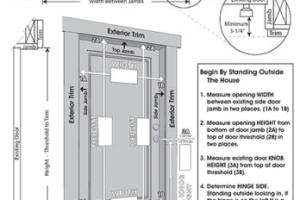Ultimate Guide: How to Accurately Measure a Screen Door for Perfect Fit

-
Quick Links:
- Introduction
- Understanding Screen Doors
- Tools You Need
- Step-by-Step Measuring Guide
- Common Measurement Mistakes
- Case Studies
- Expert Insights
- Conclusion
- FAQs
Introduction
Measuring a screen door may seem like a straightforward task, but getting it right is crucial for a proper fit and functionality. Whether you’re replacing an old screen door or installing a new one, accurate measurements can save you time, money, and frustration. In this comprehensive guide, we’ll walk you through the process of measuring a screen door with precision, ensuring your installation goes smoothly.
Understanding Screen Doors
Screen doors serve multiple purposes, including allowing fresh air into your home while keeping bugs out. They are typically made from lightweight materials like aluminum or fiberglass and come in various styles, including sliding, hinged, and retractable. Before diving into measurements, it's essential to understand the different types of screen doors available:
- Hinged Screen Doors: These are the most common type and swing open like a regular door.
- Sliding Screen Doors: Ideal for patio doors, they slide open and closed.
- Retractable Screen Doors: These can be pulled down when needed and retracted when not in use.
Tools You Need
Before you start measuring, gather the following tools:
- Measuring tape
- Level
- Pencil and notepad
- Straight edge or ruler
- Helper (optional, but recommended for larger doors)
Step-by-Step Measuring Guide
Follow these steps to measure your screen door accurately:
1. Determine the Door Type
Identify whether your door is a hinged, sliding, or retractable type as this will influence your measuring technique.
2. Measure the Door Frame
For a hinged door:
- Measure the width from the left side of the frame to the right side. Record this measurement.
- Measure the height from the top of the frame to the bottom. Record this measurement as well.
For a sliding door:
- Measure the width of the door frame where the screen will slide.
- Measure the height from the top to the bottom of the sliding track.
3. Account for Clearance
Make sure to allow for some clearance for hinges and the track. A good rule of thumb is to add ¼ inch to the width and height measurements.
4. Double-Check Your Measurements
It’s always a good idea to measure twice to avoid mistakes. Verify that your measurements are consistent.
5. Create a Measurement Diagram
Sketch a simple diagram of your door frame with the measurements included. This will serve as a visual reference when you go to purchase or order your screen door.
Common Measurement Mistakes
Even minor errors in measuring can lead to issues during installation. Here are some common mistakes to avoid:
- Not accounting for the door frame's thickness.
- Measuring only one side of the frame; always measure both sides to ensure consistency.
- Ignoring the need for clearance on sliding doors.
Case Studies
Let’s look at a few real-world examples where proper measuring made a difference:
Case Study 1: The Perfect Fit
John decided to replace his patio screen door. By following the measuring guide, he accurately determined the size. His new screen door fit perfectly without any gaps, preventing insects from entering.
Case Study 2: The Costly Mistake
Mary rushed through her measurements and ended up ordering a door that was too small. Not only did she have to reorder, but she also incurred additional shipping costs and wasted time.
Expert Insights
We spoke to home improvement expert Sarah Jones, who emphasized the importance of accuracy: “Taking the time to measure your door frame correctly can save you from a lot of headaches down the road. If you're unsure, don’t hesitate to consult a professional.”
Conclusion
Measuring a screen door is a task that requires attention to detail and patience. By following this comprehensive guide, you’ll be well-equipped to take accurate measurements for your screen door, ensuring a perfect fit and a smooth installation process. Remember, when in doubt, measure twice and consult with experts when necessary!
FAQs
- Q1: What is the standard size for a screen door?
A1: The standard size typically ranges from 32 to 36 inches in width and 80 inches in height. - Q2: How do I measure for a sliding screen door?
A2: Measure the width and height of the door frame, accounting for the sliding track. - Q3: Can I install a screen door myself?
A3: Yes, most screen doors are designed for easy DIY installation. - Q4: Do I need to measure both sides of the frame?
A4: Yes, measuring both sides helps ensure consistency and accuracy. - Q5: What if my measurements are slightly off?
A5: Small discrepancies can often be adjusted with brackets or shims. - Q6: Should I remove the existing door before measuring?
A6: It’s not necessary, but it may help to see the frame more clearly. - Q7: How much clearance should I leave?
A good rule of thumb is to leave about ¼ inch for clearance. - Q8: Can I use a regular tape measure?
A8: Yes, a standard tape measure is suitable for this task. - Q9: How can I ensure the door swings smoothly?
A: Make sure your measurements are precise and consider the weight of the door. - Q10: What materials are best for screen doors?
A: Aluminum and fiberglass are popular choices due to their durability and lightweight properties.
Random Reads